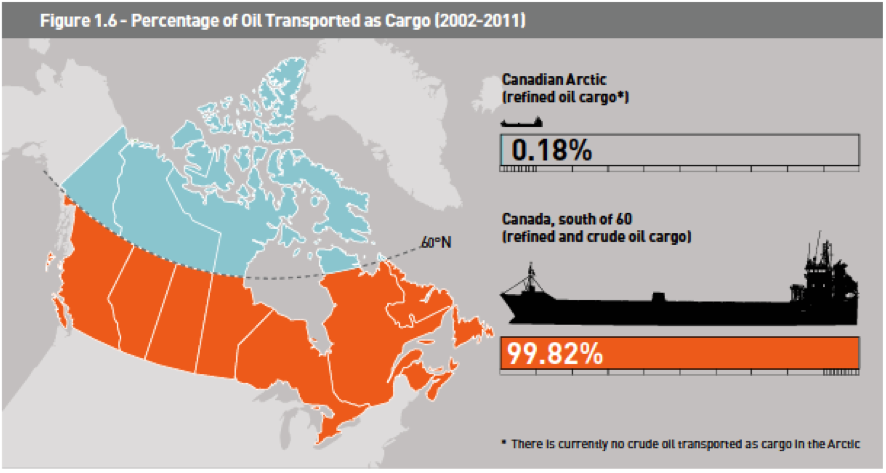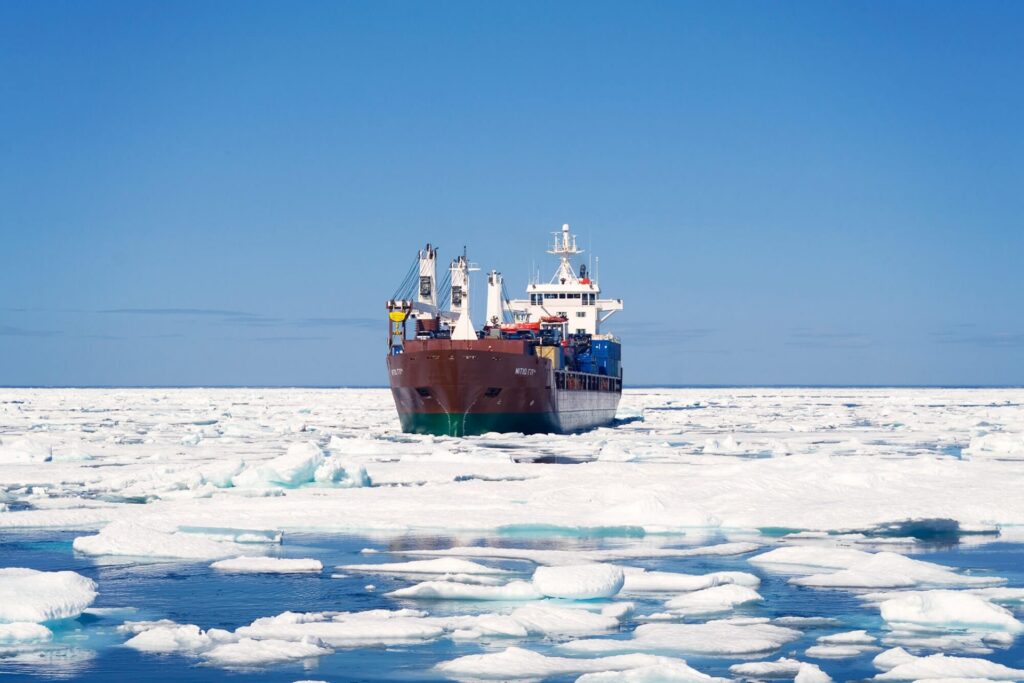Compared to areas south of the 60th parallel, the Arctic is a much more complex environment within which to prepare for and respond to spills.
Executive Summary
Clear Seas is an independent, not-for-profit organization that provides impartial and evidence-based research to inform the public and policy makers about marine shipping in Canada.
Accordingly, we are providing this digest on Transport Canada’s Tanker Safety Expert Panel’s second report titled A Review of Canada’s Ship-Source Spill Preparedness and Response: Setting the Course for the Future, Phase II – Requirements for the Arctic and Hazardous and Noxious Substances Nationally. This digest covers Chapter 1 on the Canadian Arctic.
This digest is not meant to be inclusive of all the Review’s commentary and/or recommendations, nor are the items mentioned necessarily in the same order as the original report.
Message from the Executive Director
The Canadian Arctic is among the last of the world’s near pristine ocean environments.
With climate change and longer ice-free periods, commercial shipping, mining activities, and perhaps even oil and gas exploration will become part of the landscape. The attendant potential pollution risks could become greater without adequate prevention and preparedness.
A major concern is that ship-source oil spill preparedness and response capabilities north of the 60th parallel are much less developed than those south of the 60th. This lack of preparedness needs to be addressed, which is why Clear Seas supports the 25 recommendations put forward in this Chapter of the Review. In particular, we endorse those dealing with improved navigation, the requirement for a Shipboard Arctic Spill Response Plan, and increased resources for the Canadian Coast Guard. Once implemented, these recommendations will go a long way to protecting our northern waters.
Chapter 1 The Arctic[1]
Compared to areas south of the 60th parallel, the Arctic is a much more complex environment within which to prepare for and respond to spills. There are a number of reasons for this. The climate, the remote operating environment and the presence and extent of multi-year ice all create unique challenges for mariners and the people charged with their safety. These challenges are exacerbated by such factors as out-dated nautical charts, limited communications infrastructure for transmitting meteorological and ice chart information, ice navigation systems, and gaps in terrestrial radar and Automatic Identification System coverage.
In addition, communities are fairly small and spread out along the Arctic coast, and in the event of a pollution incident, the polluter will have limited initial support available to mount a response. Further, with the gradual increase in open water as a result of polar ice melting, there are more frequent and intense maritime storms.
Despite all this, a recent assessment of the risk of ship-source spills in the Arctic commissioned by Transport Canada determined that – given the very low volumes of marine traffic and oil[2] currently transported in the Arctic – the probability of a ship-source spill is significantly lower than in the rest of Canada.

Prevention
Because spill preparedness and response is more challenging in the Arctic than in Canada’s southern waters, preventing and limiting ship-source spills[3] are the most important improvements to be made. Accordingly, the panel report details a number of strategies the government can adopt.
Navigation
At the heart of safe navigation are up-to-date nautical charts. Unfortunately, only a small percentage of northern waters have been charted to an acceptable standard. Because of the huge expanse and remoteness of the Arctic, it will be an enormous challenge to rectify this state of affairs, particularly since the short shipping season severely restricts how much work the Canadian Hydrographic Service (CHS) can accomplish each year. Consequently the Government should make it a priority to equip government vessels operating in the Arctic (such as Canadian Coast Guard icebreakers) with modern hydrographic equipment and to bring government hydrographers with them during Northern voyages. This will allow for faster collection of bathymetric (water depth) data and improve the availability of modern nautical charts.
Ice Navigators are also a critical part of the safe navigation equation. They essentially act as advisors to a ship’s master on the ice regimes through which a vessel may be navigating. This Canadian concept is now recognized worldwide as a best practice in Arctic navigation. The Arctic Shipping Pollution Prevention Regulations specify the conditions under which the use of an Ice Navigator is mandatory. Because there is currently no formalized training program or certification process for Ice Navigators, the report recommended that Transport Canada, in consultation with industry, pursue the establishment of a formal endorsement to ensure they have the required experience.
Preparedness and Response
A well-designed plan is an important first step to meet oil spill preparedness objectives. This is particularly valid for Arctic operations where response logistics are difficult and vessels may be a long way in time and distance from where response resources are located. The following recommendations address some of these objectives.
The purpose of the Shipboard Oil Pollution Emergency Plan is to provide guidance to the master, officers and crew on board the ship with respect to the steps to be taken when an oil pollution incident has occurred or is likely to occur. Canada, like the International Maritime Organization, requires such plans for tankers 150 Gross Tonnes (GT) and above and other vessels 400 GT and above.
However, at present these plans are not required to address Arctic-specific issues. Accordingly the report recommended that Transport Canada establish a new requirement for certain vessels and barges operating in the Arctic to have a Shipboard Arctic Spill Response Plan that would include all of the current requirements south of the 60th parallel, but with added obligations.
For tankers involved in transferring oil (currently only refined products), the plan should outline the vessel’s on-board preparedness capability and procedures for responding to small operational spills, such as discharges during transfer operations.
Because there are no deep-water wharves located in communities in the Canadian Arctic, the fuel supplies are usually transferred from tankers to land-based storage tanks via floating fuel hose or barges that can be beached. In recognition of the often unique challenges involved in such transfer operations, the report recommended that Transport Canada, in collaboration with appropriate stakeholders, should develop a classification structure for oil handling facilities, using a risk-based analysis that considers factors relevant to Arctic operations.
With this analysis completed, the department should also develop appropriate spill preparedness and response standards to support the development of Oil Pollution Emergency Plans that factor in considerations for the Arctic. Standards should be articulated for each of the newly developed classes of oil handling facilities.
As Transport Canada develops the regulatory requirements for Shipboard Arctic Spill Response Plans, and new standards for oil handling facilities and for barges, the department should also develop an appropriate oversight program to ensure compliance with its new requirements for vessels and oil handling facilities operating in the Arctic.
No matter the circumstances, a spill in the Arctic would be a significant challenge for responders. The availability of a full suite of response options will enhance the chances of an effective pollution response and the report recommended that the Government proceed with plans to lift legal prohibitions on using alternative response techniques, including for Arctic spills, where such techniques would provide the best outcome, according to a net environmental benefit analysis.
Regional and Local Planning
Just as it did in its first report concerning spills south of the 60th parallel, the panel report recommends a planning process for the Arctic that is risk-based and geographically-based. What is different for the Arctic is the level of detail of the plans, the structure and requirements for industry planning, as well as the involvement of various segments of industry or their representatives.
It further recommends that the Coast Guard maintain and regularly update the regional response plan for the Arctic – to reflect the most recent information on key environmental resources, evolving response tactics and available response resources. These plans should be developed in consultation with local communities, industry, other government departments and agencies, and be available to the public, potential polluters and their responders.
Canadian Coast Guard Capabilities
The CCG serves as Canada’s eyes and ears on the ocean in the North. Throughout its engagement with stakeholders, the report heard that the Canadian Coast Guard’s capabilities have been in decline in the Arctic, impacting its ability to keep up with the current modest increases in shipping and a lengthening shipping season. In order for it to adequately fulfill its role, it will need to be physically present in the Arctic for the duration of the active shipping season.
To that end, even though the CCG already has equipment and capability for responding to oil spills in the Arctic, it may require additional resource capacity that takes into account the changing operating environment in the North.
Unlike the south, there are no certified Response Organizations for Arctic spills. Preparedness in the Arctic will require ship and oil handling facility owners to identify – in their respective spill response plans – the resources they would employ to respond to a spill.
It is vital that the CCG be aware of industry plans and capabilities. Accordingly the report suggests that Transport Canada and the Coast Guard develop a collaborative mechanism to ensure that the latter has access to information about ship and oil handling facility owners’ plans for ship-source spills that will inform its role as Federal Monitoring Officer and On-scene Commander.
Community Training
To respond quickly and efficiently to an oil spill, it is important to have properly trained and equipped personnel in the North who would help facilitate the initial response. Developing a training program for the diverse and remote communities that populate Canada’s Arctic can be a challenge. Therefore all levels of government should cooperate to explore training options for oil spill preparedness and response at the community level in the Arctic, and encourage local institutions to participate in these opportunities.
Continuous Improvement
As the Arctic is vast and complex, research efforts will likely have to be focused on geographic areas of higher risk, where vessel traffic intersects with environmental sensitivities, such as: the behaviour of the substances transported most often in the Arctic and how to best respond to them; detecting and responding to oil under ice; testing the effects and effectiveness of alternative response strategies; ecosystem monitoring and classifying the different types of shoreline; and ocean modelling and monitoring.
Accordingly, the task force recommended that Environment Canada, in collaboration with Fisheries and Oceans Canada, territorial and provincial governments, academia, industry, and international partners, should prioritize efforts to fill the various knowledge gaps that exist pertaining to spill preparedness and response.
The Government also needs to continually monitor developments, particularly vessel traffic levels, to ensure that additional measures are put in place when appropriate. For example, it will need to closely monitor Arctic shipping trends over time to determine if a mandatory pilotage regime could be required for the areas at higher navigational risk. Additional investment in the National Aerial Surveillance Program, which conducts ice and pollution surveillance flights for a few months in the Arctic each year, may also be necessary.
[1] The terms “the Arctic”, “the North”, “Canadian Arctic” and “Northern Canada” are used interchangeably, and refer to the regions located north of 60 degrees, including the Mackenzie River and Delta and Great Slave Lake, as well as Hudson Bay, James Bay, Ungava Bay, and the northern Labrador Sea.
[2] Currently, the primary oil products carried as cargo in the Arctic are marine diesel, gasoline and jet fuel, all of which are non-persistent oils. Crude oil is not currently transported as cargo in the Arctic.
[3] In the context of this report, ship-source spills should be understood to include any spills that could occur during the transfer of oil between a vessel and a land-based oil handling facility, as well as spills originating from vessels.



